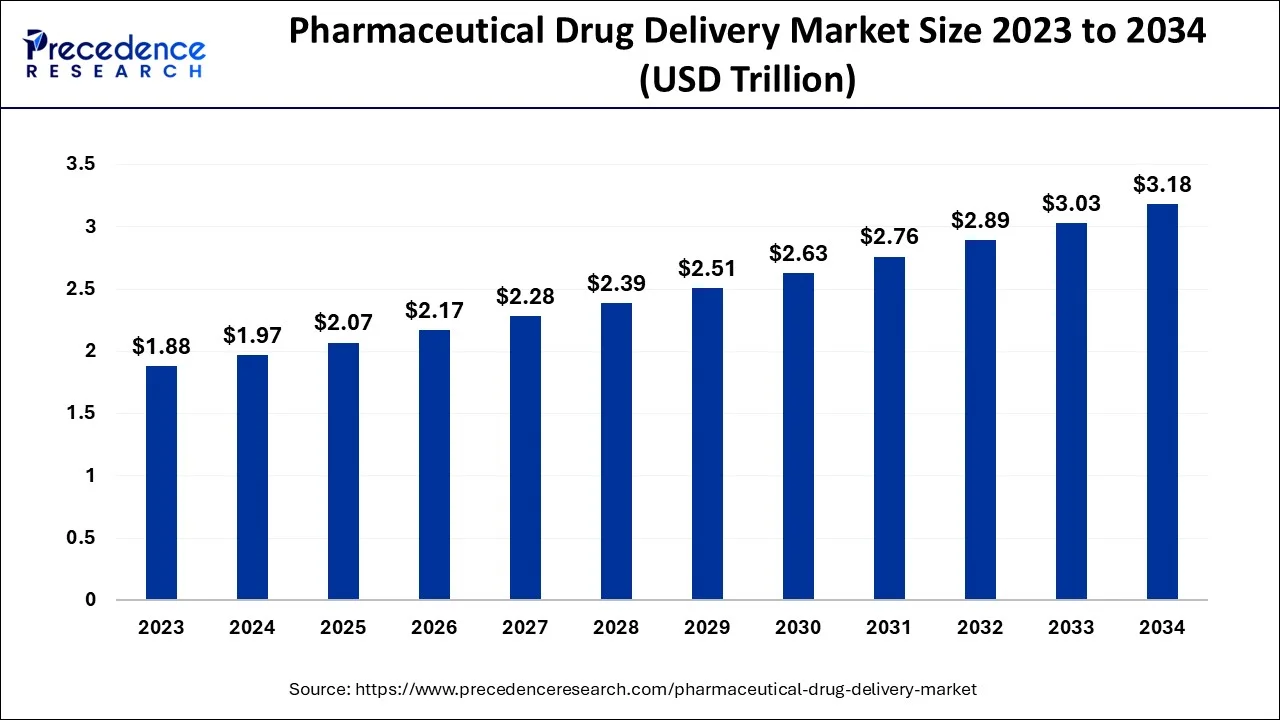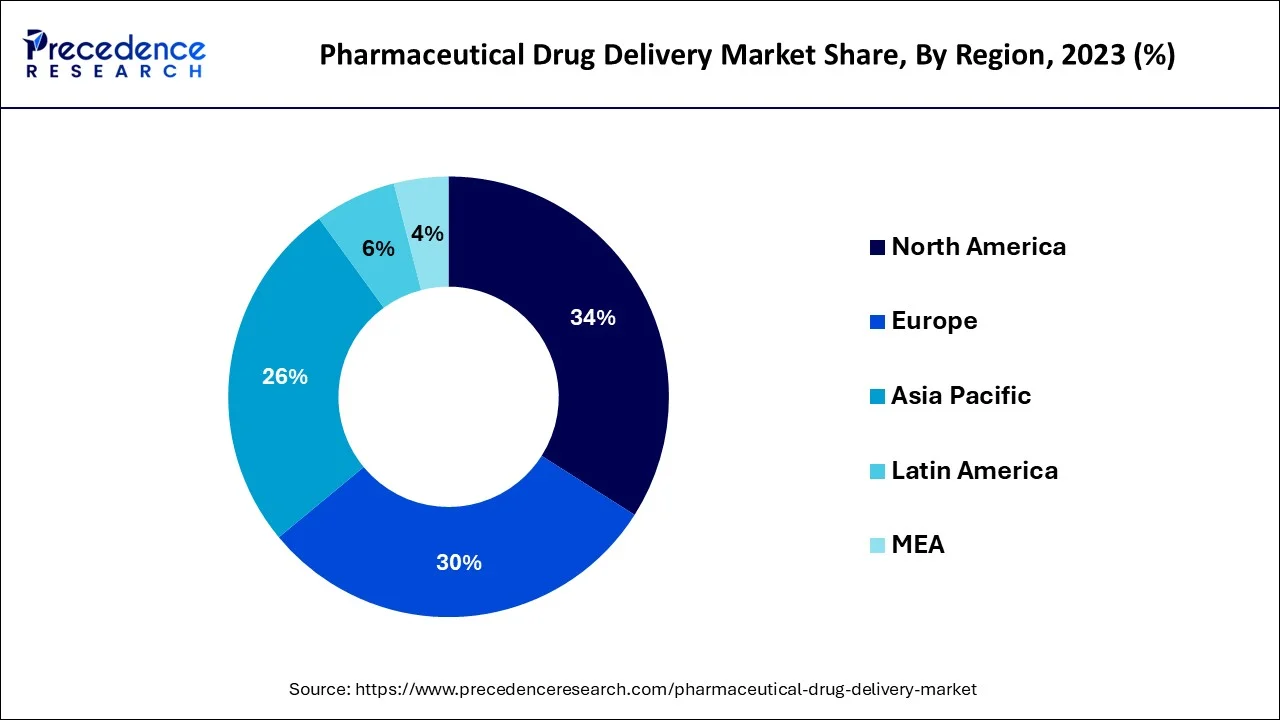May 2024
The global pharmaceutical drug delivery market size accounted for USD 1.97 trillion in 2024, grew to USD 2.07 trillion in 2025 and is projected to surpass around USD 3.18 trillion by 2034, representing a healthy CAGR of 4.90% between 2024 and 2034.
The global pharmaceutical drug delivery market size is estimated at USD 1.97 trillion in 2024 and is anticipated to reach around USD 3.18 trillion by 2034, expanding at a CAGR of 4.90% between 2024 and 2034.

Based on region, North America dominated the global market in 2023. This is attributed to the increased prevalence chronic diseases among the US population. According to a study, around 60% of the US population is suffering from at least one chronic diseases and most of them are affected with more than one disease. Moreover, the development of various innovative drugs in the biopharmaceutical industry that can treat various non-communicable diseases is exponentially fueling the demand for the pharmaceutical drug delivery solutions in North America. Furthermore, the rising demand for the personalized drugs in North America is impacting the market positively.

Asia Pacific is estimated to be the most opportunistic market during the forecast period. This is attributed to the rising prevalence of various chronic diseases among the population owing to various factors such as physical inactivity, sedentary lifestyle, and unhealthy food habits. The rapidly growing biotechnology and rising demand for the biotechnology drugs in the region is spurring the demand for the pharmaceutical drug delivery. According to the World Health Organization, maximum number of deaths due to the chronic diseases is recorded in the low and middle income countries. Therefore, the rising accessibility to the healthcare facilities is prominently driving the market growth in this region.
The global pharmaceutical drug delivery market is significantly driven by the rising prevalence of various chronic diseases such as diabetes, cardiovascular diseases, and cancer coupled with the technological advancements in the manufacturing and development of innovative devices for the pharmaceutical drug delivery. According to the International Agency for Research on Cancer, in 2020, around 19.3 million new cancer cases and 10 million cancer deaths were reported across the globe. It is estimated that around 28.4 million new cancer cases will be recorded in 2040, globally. According to the World Health Organization, the cardiovascular diseases results in around 17.9 million or 32% of the global deaths and it is a leading cause of death across the globe. As per the International Diabetes Federation, the global diabetic population is estimated to reach at 783 million by 2045. Diabetes is a prominent reason behind of kidney failure, heart attacks, blindness, and stroke. Therefore, the rapidly growing prevalence of various chronic diseases across the globe is significantly boosting the demand for the various innovative drugs for treatment, which in turn augments the demand for the pharmaceutical drug delivery solutions.
The rapidly growing biopharmaceutical industry and the development of various new and innovative drugs in the industry is significantly driving the growth of the pharmaceutical drug delivery market. The growing investments by the top pharmaceutical manufacturers in the research and development of the new drugs for the treatment of incurable diseases are augmenting the need for the various pharmaceutical drug delivery solutions around the globe. Furthermore, the presence of the several top market players in the pharmaceutical drug delivery market and the key developmental strategies such as new product launches, mergers, acquisitions, and partnerships adopted by them significantly drives the market growth. Therefore the rising penetration of the drug and gene delivery devices companies across the globe is boosting the market growth.
| Report Coverage | Details |
| Market Size in 2024 | USD 1.97 Trillion |
| Market Size in 2034 | USD 3.18 Trillion |
| Growth Rate | CAGR of 4.90% |
| Largest Market | North America |
| Fastest Growing Market | Asia Pacific |
| Base Year | 2023 |
| Forecast Period | 2024 to 2034 |
| Segments Covered | Route of Administration, Application, End User, Region |
| Regions Covered | North America, Europe, Asia-Pacific, Latin America and Middle East & Africa |
The oral segment dominated the market in 2023. The oral drug delivery is considered to be the most convenient and most common route of administration across the globe. It is non-invasive, cheap, pain-free, and self-administered type of delivery where no sterile precautions are involved. Furthermore, the introduction of different innovative drugs that can provide effective treatment of the various non-communicable diseases with low or no side-effects is significantly driving the growth of this segment. Moreover, the growing popularity of various biopharmaceutical drugs in the form of tablet and capsules is expected to have a positive impact on the growth of the oral route of administration segment.
On the other hand, the topical is estimated to be the fastest-growing segment during the forecast period. The benefits associated with the topical route of administration are non-invasiveness, ease of use, convenience, and painless delivery that may boost its adoption in the forthcoming years and drive the market growth. The introduction of time-controlled system in the topical route of administration is another factor that has potential to grab the attention of the consumers.
The cancer segment dominated the global pharmaceutical drug delivery devices market in 2023. This is attributable to the rising prevalence of cancer among the population. According to the International Agency for Research on Cancer, in 2020, around 19.3 million new cancer cases and 10 million cancer deaths were reported across the globe. The global cancer cases are estimated to grow by 47% from 2020 to 2040. It is expected that 28.4 million cases will be recorded in 2040, globally. Breast cancer, lungs cancer, bowel cancer, and womb cancer are the most prominent types of cancer that affects the people.
On the other hand, the cardiovascular segment is estimated to be the fastest-growing segment during the forecast period. This is attributed to the rising focus of the pharmaceutical companies towards the development of drugs for curing cardiovascular diseases. Moreover, the increasing prevalence of cardiovascular diseases owing to unhealthy food habits, rising obesity, and growing consumption of alcohol and physical inactivity is fueling the number of cardiovascular diseases related deaths. According to the World Health Organization, CVDs accounted for 32% of the global deaths in 2019.
The hospitals segment accounted largest revenue share in 2023. This is attributed to the higher penetration of the private and public hospitals across the global. The rising investments by the government and the corporate sector in the development of the advanced hospitals have propelled the growth of this segment. Moreover, the rising number of hospital admissions owing to the growing burden of diseases is fueling the growth of this segment across the globe.
On the other hand, the home healthcare segment is estimated to be the most opportunistic market during the forecast period. The growing geriatric population, rising personal disposable income, rising awareness regarding hospital acquired infections, and rising healthcare expenditure are the major factors that are expected to drive the growth of the home healthcare segment.
Segments Covered in the Report
By Route of Administration
By Application
By End User
By Geography
For inquiries regarding discounts, bulk purchases, or customization requests, please contact us at sales@precedenceresearch.com
No cookie-cutter, only authentic analysis – take the 1st step to become a Precedence Research client
May 2024
April 2025
February 2025
September 2024